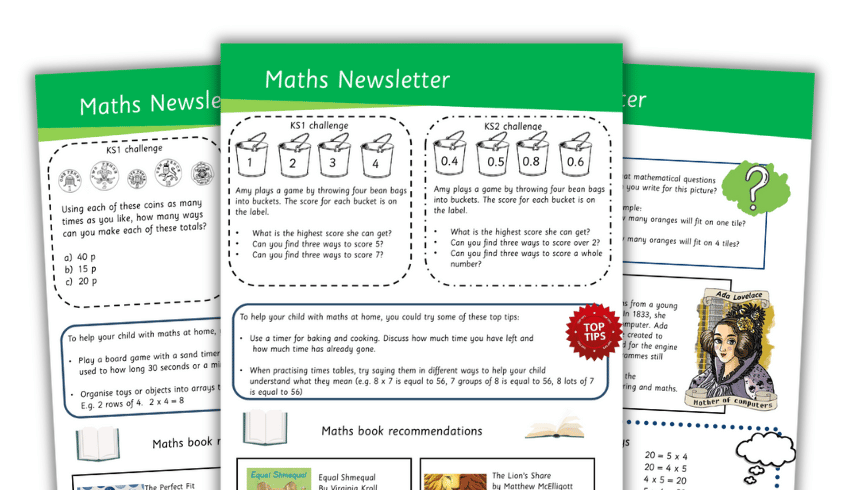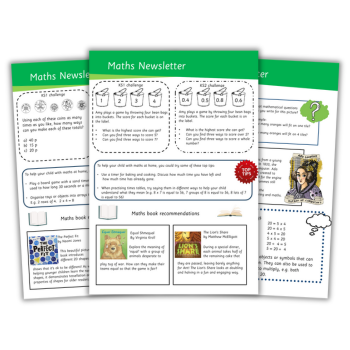Are adults at home finding it difficult to support their children with maths? Provide extra maths support for parents by sending out a regular newsletter to explain new vocab and pique their interest…

Every one of us does maths in some form every day. That might be setting a timer while cooking, working out what time to leave to get to work, or mentally calculating how many days are left until pay day.
By the time we become adults, most of this has become so ingrained that we don’t even notice or class it as ‘doing maths’.
I’ve lost count of the number of times I’ve had someone say to me that they are terrible at maths. Yet they manage these processes (and many more) every day.
Often, what it boils down to is that we can use maths in context without a problem, but we sometimes find the abstract nature of the subject – such as column subtraction or adding fractions – difficult.
Daunting
For parents who last came across formal calculation methods when they took their exams at the age of 16 or 18, supporting their child in maths may be daunting. (Especially when the likes of long division raise their heads!).
This is particularly true if they weren’t keen on maths, or struggled with it themselves when they were in school.
When I became maths lead, I wanted to start communicating with parents more effectively. I decided a digital newsletter would be the best way to do so.
Each class already sent home newsletters every term telling parents what their children would be learning in the upcoming weeks. I was keen to avoid repeating this information.
I also wanted to avoid it being too dry and information-filled. No one wants to read that when it pings into their inbox! I had two main aims: to encourage mathematical conversation at home, and to empower parents to support their children’s learning.
Since starting up the newsletter, I’ve had some great conversations with children about the different puzzles they’ve tried and how they’ve solved them.
I’ve even had a child suggest a puzzle to include! It was also really useful at parents’ evening to point parents towards the newsletter when they asked for ways to support their children in maths.
So, here’s what I include in my maths newsletters:
Math pictures
Writing maths questions relating to pictures is a very low-threshold, high-challenge activity. In my first newsletter, I used one of my favourite maths pictures: a set of kitchen tiles with some oranges lined up along two perpendicular sides of one tile (you can see it in the downloadable example).
I’ve used this with several classes in the past. Questions (depending on the level of challenge required) ranged from “How many oranges are there?” to “If the tiles were twice as big, how many boxes of ten oranges would be needed to cover them all?”
By including activities such as these, parents are provided with an easy way to talk about maths in real life examples.
Great mathematicians
In each newsletter, I include a short biography of a mathematician highlighting their main achievements. There are two main reasons for this. Firstly, it shows how maths is used outside the classroom, and how it helps to shape the world. Secondly, I use it to promote women in STEM and share their contributions.
Calculation strategy
We’ve all had someone tell us that maths has changed, or that they did it differently when they were at school.
While the fundamental basics of maths haven’t actually altered, there are a lot of new methods and new vocabulary. If you haven’t been in a classroom for a few years, this might seem daunting.
In each newsletter, I include a mathematical model or strategy. There’s a brief explanation of what it is and how to use it. This demystifies terms like ‘bar model’ and ‘array’. It helps parents understand which methods their children are being taught and how they can help them.
Primary maths challenge
Low-threshold, age-appropriate challenges again provide a chance for parents to engage in a mathematical conversation with their children in a purposeful way.
There are so many great resources out there that provide maths challenges aimed at each Key Stage. The best ones are fairly open-ended. For example, ‘How many different combinations/solutions can you find?’. This reduces the pressure of having to find one correct answer.
Top tips
By including tips on how to explore trickier subjects with their child, I wanted to provide parents with tools to enable them to drip-feed maths skills into everyday life. This is rather than doing sets of questions at home.
These tips also offer low-threat activities for children who may dislike maths. Most of these revolve around time and money, as there are often areas that children find tricky, but are also skills they need most in their daily lives.
An example might be to use a timer when playing a game, or to mentally add up the approximate cost of shopping.
Maths book recommendations
There are so many great maths-related picture books for both KS1 and KS2, but it can be hard to find them if you don’t know what you’re looking for.
Therefore, it seemed only natural to provide high-quality examples with a brief synopsis to help parents choose texts to benefit their children. The Perfect Fit by Naomi Jones is an excellent example of a maths picture book that is accessible for children of all ages: younger children can identify and name the shapes, while older children can explore tessellation and properties.
Other books such as How Big is a Million? by Anna Milbourne and How Many Jelly Beans? by Andrea Menotti expose children to large numbers in a fun and visual way.
Sarah Farrell is a KS2 teacher in Bristol who makes and shares resources online. Follow Sarah on Twitter @SarahFarrellKS2 and see more of her work at mrsfclassroom.wordpress.com.
Read about the school running maths booster classes for mums.











